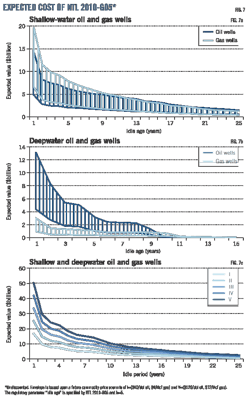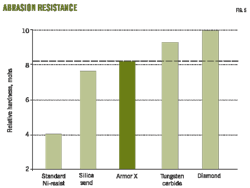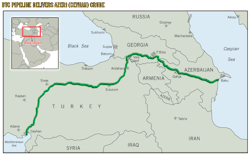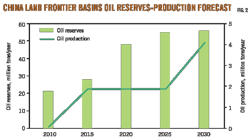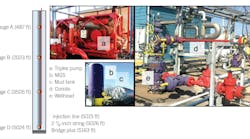Lehigh Park field in Lee County, southwest Florida, was discovered in 1974 by Exxon. Production is from the Lower Cretaceous (Aptian) age Sunniland formation in a combination structural-stratigraphic trap at an approximate depth of 11,500 ft.
Lehigh Park field is the northwesternmost of 14 oil fields discovered to date in the Sunniland trend. Cumulative production from this trend exceeds 100 million bbl of oil. Production through December 2008 at Lehigh Park is about 5.9 million bbl of oil from five wells, only one of which is still producing. The field's oil has an API gravity of about 28o, a low gas-oil ratio, and a moderately high sulfur content.
Lehigh Park field represents the approximate mean size of anticipated future onshore discoveries in the Sunniland Trend and thus can be used as model for risk evaluations for that play. From a sequence stratigraphic aspect, it represents deposition in a relatively shallow water patch reef environment during periods of more open circulation in a rimmed arid shelf setting.
This means that offshore portions of the basin, which have been not explored, may contain much larger hydrocarbon reservoirs formed in grainstone shoal and boundstone reef settings.
In addition to the Sunniland formation, which is commonly subdivided into four productive intervals, several other carbonate-evaporite cyclothems are present in deeper intervals in the basin.
The paucity of deep tests in the South Florida basin, combined with favorable petroleum source, reservoir, and trapping characteristics; as well as proximity to Mesozoic production in the Sonda de Campeche and northern Cuba provinces, make the South Florida basin an underexplored but attractive area for future petroleum exploration.
Introduction
The Sunniland formation is one of several carbonate-evaporite cyclothems present in the Lower Cretaceous of South Florida.
The Lower Cretaceous-age section in South Florida is typically about 3,500 ft thick, and the Sunniland formation is about 250 ft thick (Fig. 1). The formation was named after the initial field discovery in the trend, at Sunniland, in 1943, located about 24 miles southeast of Lehigh Park field, in Collier County (Fig. 2).
Sunniland field was discovered by Humble Oil (now Exxon). Exxon has been the dominant explorer in the trend. It also discovered West Felda field, the most productive (about 48 million bbl of oil) field in the trend, located 8 miles southeast of Lehigh Park.
Exploration methods initially used by Humble Oil included gravity and magnetics, structural mapping from shallow (usually about 1,200 ft deep) stratigraphic test holes, and seismic. Until relatively recently, seismic quality was rather poor in this area due to interference from evaporite beds, present in the thick Eocene through Jurassic section and other stratigraphic features, including the high permeability zones in the Eocene age Oldsmar formation, commonly referred to as the "boulder zone."
As the number of exploratory wells in the trend increased, the importance of subsurface mapping has also increased.
Oil from the Sunniland formation fields typically has gravities in the mid to high 20o range, low gas-oil ratios, and moderately high sulfur content. It is trucked from the Lehigh Park tank battery to Port Everglades in Fort Lauderdale, from where it is transported by tanker, usually to refineries in the Texas Gulf Coast. Large volumes of hypersaline produced water are also common, requiring installation of water disposal wells.
The Sunniland formation is a self-contained petroleum system with its own reservoir, source rock, and trap. The reservoir is provided by porous dolomitic limestones that were deposited in shallow water biohermal buildups. Primary depositional porosity is the dominant porosity type, with later enhancement by partial dolomitization.
The source rock is dark micritic, moderately organic-rich limestones in the lower part of the Sunniland formation. Thick anhydrite beds overlie (Lake Trafford anhydrite) and underlie (Punta Gorda anhydrite) the Sunniland formation.
Structural trapping of the hydrocarbons at Lehigh Park is due to four-way closure related to the breaking of a southeast plunging anticlinal nose by a small northeast trending, high-angle, normal fault1 (Fig. 3).
Field discovery
Because the Lehigh Park field area is only 8 miles from West Felda field, discovered in 1966, and updip from West Felda along the same plunging anticlinal nose, exploration in the Lehigh Park area was to be anticipated.
However, because one large land development company, the Lehigh Acres Development Corp., controlled most of the surface and mineral rights in the area, and most of the area had been planned for residential development, access for petroleum exploration was limited to lots platted for future church sites by that company or to the few parcels controlled by others.
Prior to completion of the Lehigh Park field discovery well in July 1974, only two petroleum test wells had been drilled in the area proximal to the field. One of these was a shallow (3,018 ft) test drilled in 1924 by Florida Exploration.
A summary of Exxon's discovery well is provided (Table 1).
In 1980 the discovery well was plugged back to 6,800 ft, sidetracked to the southeast, and recompleted as the 22-4A. All four of the field development wells were drilled as directional holes. The tank batteries for the field are located at the site of the discovery well, in a lightly populated suburban-rural area, south of the old Buckingham Army Air Force Base, a World War II era training facility.
Reservoir geology
The Sunniland formation was subdivided in this field study into four units, which with increasing depth, as shown on cross-section A-A' (Fig. 4), have been labeled as Zones A through D.
Porosity development is possible in each zone. Dense, low porosity, correlatable stratigraphic units provide vertical separation between these zones. Porosity is best developed in Zone B at Lehigh Park field; this is the producing interval in the field. A porosity isopach map for Zone B (Fig. 5) shows the extensive porosity buildup in the field area.
In a core study2 of the Sunniland formation in Lehigh Park field, 11 carbonate and evaporite facies were described and attributed to five depositional environments. These are, in order of decreasing water depth, shallow water shelf, shoal water bioherm, restricted and open lagoon, tidal flat, and sabkha. The hydrocarbon-productive zone was determined to have been deposited in shoal water biohermal patch reef environments. These deposits are thought to have undergone early subaerial exposure and diagenesis that preserved the initially high primary interparticle porosity and enhanced it with secondary moldic and vugular porosity.
Winston3 described an idealized, repeatable set of cyclical lithofacies in the Sunniland formation of South Florida. These facies are, within a single cycle: anhydrite, microcrystalline dolomite with interbedded anhydrite, micritic limestone, chalky limestone, calcarenitic limestone, followed by a repeat of the previous lithofacies in reverse order, terminating in the anhydrite lithofacies.
Within the Sunniland at a particular location some of the end members of this idealized cyclothem may not be present. The calcarenitic limestone unit, corresponding to the shoal water biohermal depositional environment of Ferber and Lock,2 provides the best potential for reservoir development.
The basal zone of the Sunniland is composed of dark grey micritic to argillaceous limestones. It is sometimes referred to as the "rubble zone." Total organic carbon contents range between 0.4% and 3.0% in this unit along the Sunniland productive trend.4 The onset of oil generation probably began during the Late Paleocene or Eocene. Oil generation in this system continues to the present. The low geothermal gradient in South Florida is responsible for the relatively immature character of the Sunniland oil.
A summary of general reservoir and field data for Lehigh Park field is provided in Table 2.
Production history
Subsequent to the completion of the field discovery well in 1974, four additional producing wells were completed in Lehigh Park field.
These development wells were drilled in 1976 and 1977. A summary for the productive wells in the field is provided as Table 3. A graphical summary of historical production is provided as Fig. 6. The one well that remains on production is the 26-2 Consolidated-Tomoka. The other four former producers have been plugged and abandoned.
Field significance
Lehigh Park field is the northwesternmost of 14 Lower Cretaceous-age Sunniland oil fields in the South Florida basin.
The Sunniland fields are combination structural-stratigraphic traps with porosity development occurring in biohermal algal mounds formed on subtle seafloor highs related to faulting in the underlying basement.
Available Bouguer gravity data indicate the trend could continue farther to the northwest toward the northwest boundary of the basin, which is the Sarasota arch. Exploration has been sparse in that area, likely due to higher population and urban-suburban development.
The possibility of subparallel Sunniland trends downdip and to the southwest is likely.5 The area immediately southwest of the trend has generally been characterized as basinal anhydrite facies6 but more likely represents a salina environment during sea level lowstands in the context of current carbonate sequence stratigraphic models.7 Exploration has been very sparse in the deeper basin area, which is mainly offshore.
In its year 2000 assessment of the onshore and state waters (i.e., to 12 miles offshore) portion of the South Florida basin,5 the US Geological Survey calculated a mean of 25 undiscovered fields in the Sunniland Trend with mean field size of 5 million bbl of oil. Thus, Lehigh Park field is significant from the aspect that it would be a typical analog for future discoveries in the onshore portion of the trend.
The USGS5 recognized two petroleum systems in the South Florida basin—an oil-prone Dollar Bay/Sunniland system and an underlying gas-prone system below the Punta Gorda anyhydrite. Numerous oil shows have been reported in the Dollar Bay formation, which is generally about 2,000 ft shallower than the Sunniland but is so far unproductive.8
Potential reservoirs in the deeper system include the Twelve Mile member of the Lower Cretaceous (Aptian) age Lehigh Acres formation, Pumpkin Bay formation (Barremian-Aptian), and Bone Island formation (Berriasian-Barremian), and the Upper Jurassic (Tithonian) Wood River formation. All of these potential reservoirs are carbonates with the exception of some sand units in the Wood River. Potential source rocks are present in all of these formations.4 Oil or gas shows have been reported in each of these formations at various locations in the South Florida basin.
The method typically utilized to date to evaluate the potential of deeper (i.e., pre-Punta Gorda anhydrite) reservoirs in the South Florida basin has been to drill one deep test in each Sunniland field. The number of such penetrations, when combined with deep wildcat tests, is extremely small for a basin as large as the South Florida basin.
The rationale for drilling the deep tests in the Sunniland fields may not be valid in that it assumes that similar trapping mechanisms would be present in the deeper section. A total of approximately 26 pre-Punta Gorda tests (21 onshore and 5 offshore) have been drilled in the South Florida basin. The basin has an area of about 80,000 sq miles (Fig. 7).
Prior to the opening of the Gulf of Mexico in the Paleocene, the South Florida basin was most closely related geographically to the Sonda de Campeche of the Mexican Gulf Coast. Paleogeographic setting and depositional environments during the Late Jurassic and Early Cretaceous were very similar for these two areas during the formation of the proto Gulf of Mexico.
Although the Sonda de Campeche petroleum province has undergone a distinct and significantly different postburial, structural, and diagenetic geologic history9 since the opening of the gulf, the original rock type and age of the reservoir and source rocks are similar. Therefore, the world-class production from the Sonda de Campeche should serve as encouragement for future exploration in the South Florida basin.
To date, the USGS has not assessed the petroleum potential of the offshore (i.e., federal waters) of the South Florida basin.
In its 2000 assessment of the onshore and state waters portion of the basin, the USGS noted that oil expulsion rates in the Sunniland formation should be higher in the offshore portion of the basin than in the onshore portion due to deeper burial and entrance into the oil window earlier. Sequence stratigraphic models also indicate that much larger hydrocarbon accumulations could be present in the offshore portions of the basin, potentially up to giant field size.
The presence of more significant structural features and related hydrocarbon traps is also likely in the offshore portion of the basin due to closer proximity to structural elements related to the evolution of the Gulf of Mexico.
A recent inventory10 of world petroleum reserves and historical production concluded that 56% of all petroleum discovered to date has been from carbonate reservoirs, and of that 64% has been in traps that have anhydrite seals.
Thus, the offshore portion of the South Florida basin, which contains the distal depositional settings of a rimmed arid carbonate shelf during the Mesozoic, is one of the few areas in the US that remains essentially untested. It has been under a federal drilling moratorium since 1982 (currently scheduled to expire in 2022) but potentially could be a location for prolific domestic hydrocarbon production, with fields that could compare to those of the Sonda de Campeche.
References
1. Acquaviva, D.J., and Nedorub, O.I., "Petroleum geology of the Lehigh Park field and its implications for future exploration in the South Florida basin" abs., in Geological Society of America Abstracts with Programs, Vol. 40, No. 6, 2008, GSA/GCAGS Joint Annual Meeting, 2008, p. 482.
2. Ferber, R.J., and Lock, B.E., "Depositional environments of Sunniland formation and diagenetic characteristics of productive facies, Lehigh Park field, Florida," abs., AAPG Bull., Vol. 69, No. 9, 1985, pp. 1420-21.
3. Winston, G.O., "Oil occurrence and Lower Cretaceous carbonate-evaporite cyclothems in South Florida," AAPG Geologic Notes, Vol. 56, No. 1, 1972, pp. 158-160.
4. Palacas, J.G., Anders, D.E., and King, J.D., "South Florida Basin—prime example of carbonate source rocks of petroleum," AAPG Studies in Geology 18, "Petroleum Geochemistry and Source Rock Potential of Carbonate Rocks," 1984, pp. 71-97.
5. Pollastro, R.M., Schenk, C.J., and Charpentier, R.R., "Assessment of Undiscovered Oil and Gas in the Onshore and State Waters Portion of the South Florida Basin, Florida, USGS Province 50," USGS Digital Data Series 69-A, 2001, 70 pp.
6. Winston, G.O., "Regional structure, stratigraphy, and oil possibilities of the South Florida Basin," in GCAGS Transactions, Vol. 21, 1971, pp. 15-29.
7. Handford, R.C., and Loucks, R.G., "Carbonate depositional sequences and system tracts—responses of carbonate platforms to relative sea level changes," in Loucks, R.G., and Sarg, J.F., eds., "Carbonate Sequence Stratigraphy, Recent Developments and Applications," AAPG Memoir 57, 1993, pp. 3-41.
8. Winston, G.O., "The Dollar Bay Formation, of Lower Cretaceous (Fredericksburg) Age in South Florida: Its Stratigraphy and Implications," Florida Bureau of Geology Special Pub. 15, 1971, 99 pp.
9. Mitra, S., Figueroa, G.C., Garcia, J.H., and Alvardo, A.M., "Three-dimensional structural model of the Cantarell and Sihil structures, Campeche Bay, Mexico," AAPG Bull., Vol. 89, No. 1, 2005, pp. 1-26.
10. Kendall, C.G., Weber, L.J., and Alsharhan, A.S., "The common association of giant oil fields with evaporates: linked by both pull apart and collision of continents, climate, basin position, and sea level" abs., in 2009 AAPG annual convention abstracts, 2009, p. 113.
Bibliography
Lloyd, J.M., 1997, 1994, and 1995 Florida Petroleum Production and Exploration, Florida Geological Survey Information Circular No. 11, Tallahassee, Fla., 62 pp.
Faulkner, B.M., and Applegate, A.V., "Hydrocarbon exploration evaluation of the Pulley Ridge area, offshore South Florida Basin," in "Transactions-Gulf Coast Association of Geological Societies," Vol. 36, 1986, pp. 83-95.
The authors
California
Venoco Inc., Denver, plans to drill at least five vertical Monterey shale exploratory wells and shoot 3D seismic over parts of its acreage in California in 2010.
The company spent minimally for onshore Monterey shale work in 2009 and accelerated leasing in the second half of 2009. It expects to aggressively add acreage this year.
The 2010 Monterey onshore budget is $26 million, but the company may hike that later in the year. The first half program is focused on science, but "we expect to begin testing various completion techniques that have been successful in unconventional reservoirs in other parts of the country," Venoco said.
Utah
Two companies encountered oil in four Jurassic zones and ran production casing to 1,100 ft to test an indicated discovery in Grand County, Utah, in the northern Paradox basin.
Tidewater Oil & Gas Co. LLC, Denver, and Forest Gate Energy Inc., Montreal, drilled the Tidewater-State well, in 3-22s-19e, 20 miles west of Cisco Dome field, to a TD of 3,050 ft to Triassic Wingate sandstone (OGJ Online, Jan. 25, 2010).
Forest Gate reported the following results from a third party evaluation of the well on its Crescent Junction property:
• 40 ft of potential oil pay at 390-430 ft with 28% porosity and a calculated 37% water saturation in the Brushy Basin member of the Morrison formation.
• 50 ft of potential oil pay at 770-820 ft with 20% porosity and 39% water saturation in the Lower Salt Wash member of Morrison.
• 10 ft of potential oil pay at 830-840 ft with 20% porosity and a calculated 37% water saturation in the Lower Salt Wash.
• 30 ft of potential oil pay at 870-900 ft with 20% porosity and a calculated 50% water saturation in the Lower Salt Wash.
The Brushy Basin and Lower Salt Wash have produced oil for many years at Cisco Dome field, Forest Gate noted. The well also yielded important data to help target the Wingate at future wells, the company said.
Forest Gate holds varying interests in 121,000 gross acres and 31,335 net acres in Utah and has an option to acquire a 50% interest in a further 135,505 gross acres and 37,264 net acres in the state.
More Oil & Gas Journal Current Issue Articles
More Oil & Gas Journal Archives Issue Articles
View Oil and Gas Articles on PennEnergy.com
